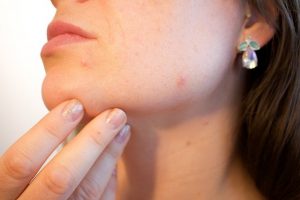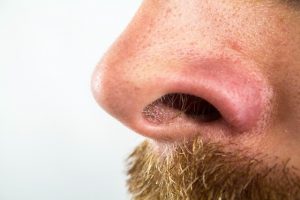It is a regular shot every evening: after removing your make-up, check whether new black or white dots have already appeared on your nose! But how do these blackheads actually arise, and more importantly: what can you do about it? We tell you everything you need to know!
 What are blackheads?
What are blackheads?
Blackheads, aka comedones, are partial or complete blockages of your pores. You know pores as those little holes in your skin! They are actually the exits of your sweat glands and the sebaceous glands that belong to your hair follicles. When your pores become clogged with sebum and dead skin cells, a black or white dot forms between one and three millimeters in size. We call this a blackhead. Blackheads usually form in your T-zone, or on your forehead, nose and chin. They are common in adolescents, but also among adults. There are two types of blackheads: blackheads and whiteheads.
Blackheads
Blackheads, or open comedones, are most recognizable by their black dots. These blackheads have a larger opening at the end of your pore, which is filled with a wad of sebum and old skin cells. When the sebum oxidizes in this accumulation, or reacts with oxygen in the air, the blackhead takes on its distinctive black color.
Whiteheads
Whiteheads, or closed comedones, look like white dots or bumps that resemble barley grains . These blackheads have a narrower opening at the end of your pore. As a result, the blockage of sebum can react less with the air, so that it does not turn black. Closed comedones therefore remain clearly visible as white accumulations.
How do blackheads develop?
Sebum is actually meant to keep your skin and hair follicle supple. This greasy substance protects your skin and hair against dehydration, bacteria and fungi. So quite handy! But an excess of sebum mixed with dead skin cells causes an accumulation or blockage in your pore. There can be several reasons for this:
- Hormones

- Nutrition
- Makeup
- Certain skin care products
- Medical conditions and medication
- Blackheads and hormones
Blackheads are very common among adolescents and that has everything to do with hormones. Some hormones produce larger, more active sebaceous glands, creating excess sebum. Not only does this cause blackheads, but it can also lead to an increase in the bacteria that causes acne in your pores. The emergence of blackheads in puberty often coincides with the appearance of childhood pimples. Hormonal changes before and during your period can also play a role in the development of blackheads.
Blackheads and food
Eating and drinking dairy products can also play a role in hormonal changes. For example, dairy naturally contains the male hormone androgen, which can affect your sebum production. In addition, eating sugar produces the hormone insulin, which in turn stimulates the production of growth hormones and androgens. All these hormones increase the production of sebum and inflammatory values in your blood. The result: more chance of blackheads and pimples .
Blackheads and makeup
If you have blackheads, you may feel the need to camouflage them with a layer of makeup. But beware: it is precisely the use of too oily makeup that can close your pores and cause blackheads!